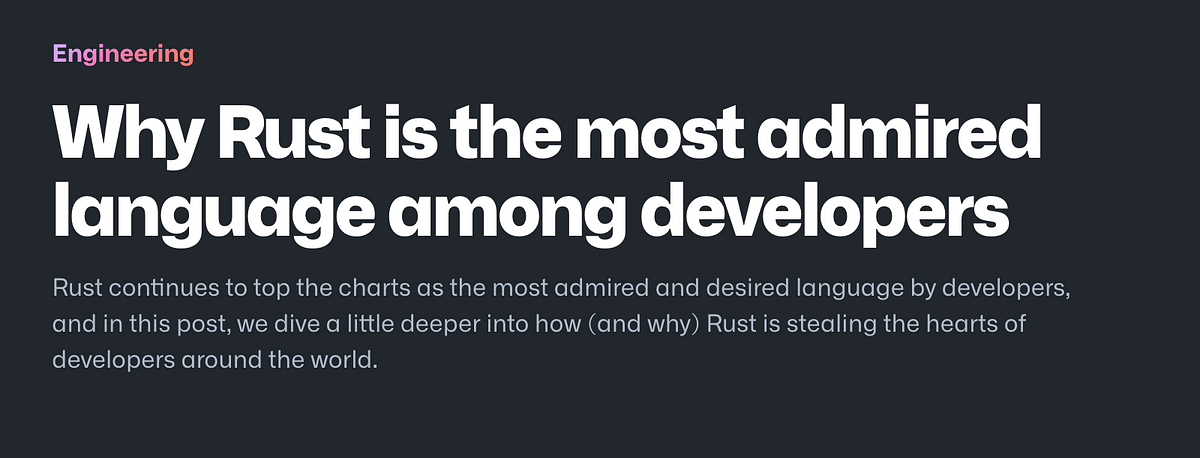Reflection on Building an Algorithmic Trading System in Rust
Conceitos Básicos
Despite the significant performance benefits of using Rust for developing an algorithmic trading system, the language comes with unique challenges and complexities that can be unexpected and difficult to navigate.
Resumo
Building an algorithmic trading system in Rust presented both advantages and challenges. While Rust's speed and safety features significantly enhanced performance, the language's complexity, opinionated nature, and lack of certain conveniences like MongoDB ORM posed unexpected hurdles. The author highlights the need for a nuanced understanding of Rust's syntax and concepts to effectively leverage its capabilities while acknowledging its potential for high-performance applications.
Customize Summary
Rewrite with AI
Generate Citations
Translate Source
To Another Language
Generate MindMap
from source content
Visit Source
medium.com
I Built an Algorithmic Trading System in Rust. Here’s What I Regret.
Estatísticas
Among all programming languages, Rust stands as one of the fastest languages.
Backtests that required several seconds in TypeScript were finished in just a few hundred milliseconds on NexusTrade.
The author rates Rust 8.4/10 for performance optimization.
Citações
"I spent this entire article talking about what I dislike about Rust. In reality, I don’t hate the language." - Austin Starks
"If a language was truly perfect, why would other languages exist?" - Austin Starks
Principais Insights Extraídos De
by Austin Stark... às medium.com 03-05-2024
https://medium.com/@austin-starks/i-built-an-algorithmic-trading-system-in-rust-heres-what-i-regret-a89f378b22c9
Perguntas Mais Profundas
How can developers effectively balance the benefits of Rust's performance with its inherent complexities?
Developers can effectively balance the benefits of Rust's performance with its inherent complexities by adopting a structured approach to learning and implementing the language. This includes taking the time to thoroughly understand Rust's unique features such as ownership, borrowing, lifetimes, and pattern-matching. By investing in comprehensive research and practice, developers can gradually acclimate themselves to Rust's syntax and type system, thereby reducing the steep learning curve associated with the language. Additionally, leveraging resources like ChatGPT or seeking guidance from experienced Rust developers can provide valuable insights and assistance in navigating through complex challenges. Ultimately, striking a balance between embracing Rust's high-performance capabilities while managing its intricacies requires patience, persistence, and a willingness to learn from both successes and setbacks.
What are some potential strategies to simplify working with Rust while maintaining its high-performance standards?
Some potential strategies to simplify working with Rust while maintaining its high-performance standards include:
Utilizing tools like ChatGPT or engaging with online communities for guidance on specific issues.
Breaking down complex tasks into smaller manageable components for easier implementation.
Leveraging existing libraries or frameworks that align with project requirements to streamline development processes.
Implementing best practices in code organization and documentation to enhance readability and maintainability.
Continuously refining coding skills through practice exercises and hands-on projects to strengthen proficiency in using Rust efficiently.
By incorporating these strategies into their workflow, developers can navigate through Rust's complexities more effectively while upholding the language's reputation for delivering exceptional performance outcomes.
How might the experience of building an algorithmic trading platform in Rust compare to other high-speed programming languages like Go?
The experience of building an algorithmic trading platform in Rust compared to other high-speed programming languages like Go may present distinct advantages and challenges based on each language’s design principles. While Go offers simplicity in terms of syntax and ease of use due to features like garbage collection which simplifies memory management tasks compared to manual memory handling required by Rust’s borrow checker mechanism; however, this convenience comes at a slight cost of reduced performance efficiency when compared against rust’s optimized resource utilization capabilities.
In contrast, developing an algorithmic trading platform in rust involves overcoming initial hurdles related complexity stemming from concepts such as ownerships,borrowing,lifetimes,pattern matching etc., but once mastered,rust provides unparalleled speed,optimal resource usage,and robust error prevention mechanisms making it ideal choice for mission-critical applications where reliability is paramount.In conclusion,the decision between choosing rust over go depends largely on trade-offs between ease-of-use vs optimal performance considerations dictated by specific project requirements
0
